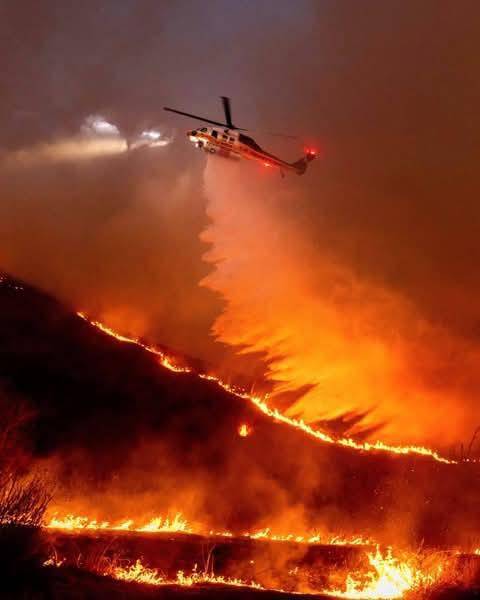The Unfolding Impact of Wildfires in the USA: Facts, Damage, and Controversies.
Before the fire outbreak.
Wildfires have increasingly become a recurring tragedy in the United States, wreaking havoc on lives, properties, and natural resources. In recent months, the U.S. has witnessed catastrophic fire outbreaks, especially in regions like California and Hawaii. These wildfires have destroyed billions of dollars worth of property, displaced thousands of families, and sparked widespread debates and conspiracy theories. Below is a comprehensive look at the facts, damages, and controversies surrounding these tragic events.
The Devastation Caused by Wildfires.
Wildfires in the U.S. have caused unprecedented levels of destruction. In California, for instance, the recent fires have obliterated residential neighborhoods, commercial establishments, and vast acres of forest. Reports estimate the economic losses to range between $52 billion and $57 billion, accounting for property destruction, loss of business, and the cost of firefighting efforts.
Hawaii has also suffered extensively, with the Maui wildfires becoming one of the deadliest in U.S. history. Entire communities were wiped out, with over 100 confirmed deaths and many still missing. These disasters are not only financially costly but also emotionally devastating for those affected.
The Causes and Escalation of Wildfires.
Several factors contribute to the increase in wildfire frequency and intensity. Climate change plays a significant role, as rising temperatures and prolonged drought conditions create a perfect environment for fires to ignite and spread rapidly. Human activities, including poor land management and accidental ignition, also exacerbate the problem.
In some cases, outdated infrastructure, such as poorly maintained power lines, has been blamed for sparking fires. Legal battles are ongoing against utility companies held responsible for negligence.
Conspiracy Theories and Controversies.
Whenever a disaster strikes, misinformation and conspiracy theories often follow, and wildfires are no exception. Social media platforms have been flooded with unfounded claims regarding the origins of the fires. Some theories suggest deliberate targeting of certain areas, citing the survival of palm trees amidst destroyed properties as evidence of selective destruction.
Experts, however, dismiss these theories. Palm trees are known to withstand fires better due to their high moisture content and thick bark. Yet, such explanations often fail to gain traction against sensational claims.
Another contentious narrative links the failure of firefighting responses to diversity, equity, and inclusion (DEI) policies within fire departments. Public figures, including Elon Musk and Donald Trump Jr., have amplified these claims, arguing that DEI initiatives compromise efficiency. Firefighting agencies have strongly refuted these allegations, emphasizing their commitment to saving lives and property.
Addressing the Spread of Misinformation.
Misinformation surrounding wildfires not only misleads the public but also hampers relief efforts. False claims about arson, poorly equipped firefighters, and government conspiracies detract from the real issues at hand. Authorities, including fire departments and law enforcement, are working diligently to counter these narratives with factual information.
One particularly damaging rumor suggested that firefighters were using ineffective tools due to budget cuts. However, officials have confirmed that response teams are equipped with state-of-the-art technology to combat these blazes.
The Path Forward: Prevention and Recovery.
As the nation grapples with the aftermath of these disasters, attention must turn to prevention and recovery. Experts advocate for stricter land management policies, including controlled burns to reduce the amount of dry vegetation that serves as fuel for wildfires. Upgrading infrastructure to withstand extreme weather conditions is also crucial.
On a broader scale, addressing climate change is imperative. Policies aimed at reducing greenhouse gas emissions and promoting renewable energy sources can help mitigate the long-term risks of wildfires.
For those affected, recovery efforts are underway. Federal and state governments, along with nonprofit organizations, are providing financial assistance and temporary housing. Community-led initiatives are also playing a vital role in rebuilding lives and restoring hope.
Why Staying Informed Matters.
Understanding the realities of wildfires is essential for creating informed communities. Relying on credible sources for information can prevent the spread of misinformation and ensure that relief efforts are directed where they are most needed.
As investigations continue into the causes and consequences of these fires, it is crucial to approach the situation with a critical mind and a compassionate heart. By staying informed and proactive, we can collectively work towards minimizing the impact of such disasters in the future.
Conclusion.
The wildfires in the U.S. serve as a grim reminder of the fragility of our environment and the importance of resilience in the face of adversity. While the devastation is undeniable, it also presents an opportunity for meaningful change. From addressing the root causes of climate change to combating misinformation, every step taken in the right direction can make a difference.
By sharing accurate information and supporting affected communities, we can turn these tragedies into a catalyst for a safer and more sustainable future.


